#garden birds nesting wildlife nature Robins Squirrel
Text
Sunday 9th May 2021
Zzzzzzzzz Please
So soon after posting about my better nights’ sleep it’s all gone a bit to pot. Ask me who’s been up since 05.35, go on. Actually don’t bother, it’s a rhetorical question. After managing to stay fast on through the dawn chorus (currently around 04.25 if you’re interested) I was woken for the second time this week by rhythmic banging penetrating my slumbers. Knowing exactly what that means I flew out of bed and flung open the curtains while knocking at the window pane for added effect.
Crow had checked the nest box in question and declared it unoccupied the first time this happened, but there’s no way Woodie would be attacking for no reason.
We tried to nod off again but it was hopeless and so tea and toast in bed in was. As it happened it was just as well we were awake because for a good 15 minutes I was up and down to the windows as the alarm calls of a Blackbird and various other birds rang out.
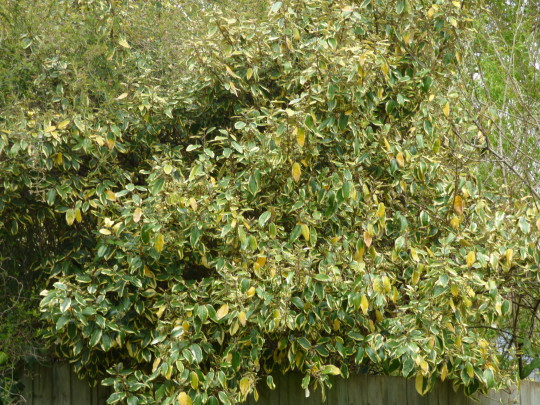
The fence between our garden and next door is clothed in greenery, or should I say, much like Norwich, green and ‘goldery’ (just exercising my football knowledge there) and this area seems to be home to multiple nests this year. It’s adjacent to ‘The Corridor’ which runs alongside our house and beyond and is a tangle of all kinds of shrubs and some lovely Jasmine on our side. Crow’s nicknamed the whole area ‘The Nursery’
We stood looking out and saw several Blue Tits, a few Great Tits, Goldfinch, Chaffinch and House Sparrows as well as the Blackbird - a lot of them gathered in the big tree that grew out of the hedge, which is so popular as a staging post. Sure enough a Magpie and a Great Spotted Woodpecker were there too, berated by the mob.
What with fending off marauding birds and marauding Squirrels, it’s exhausting.
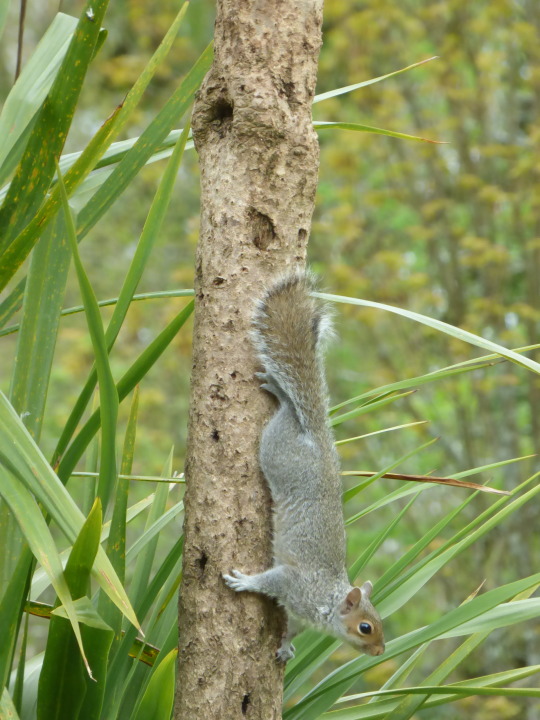
‘You ain’t seen me, right’ (A Fast Show reference by the way) Squirrel refines the art of camouflage when seen from a distance.
Talking of Squirrels, have you ever seen a Squirrel’s tongue? If not...you have now.
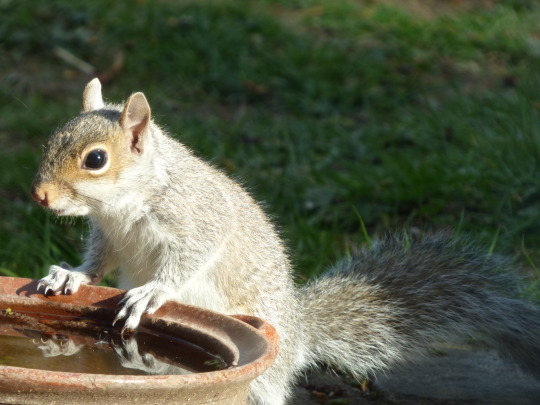


Talking of body parts - have you ever noticed how hairy a cat’s ears can be?
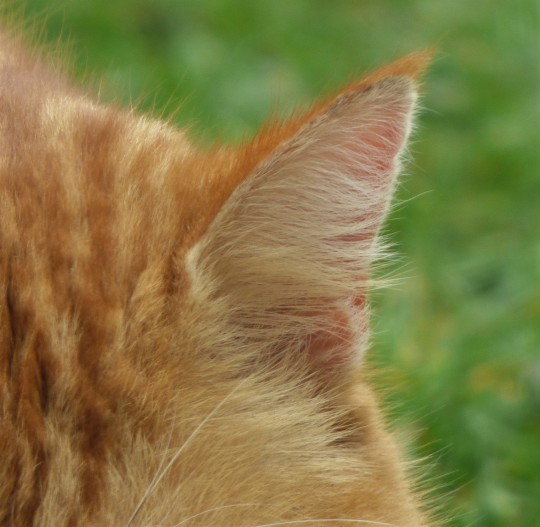
M. Flambeau’s been back this week, not giving the bird life any aggravation though, so at least we have one garden visitor who’s behaving and who’d have thought it would be a cat!
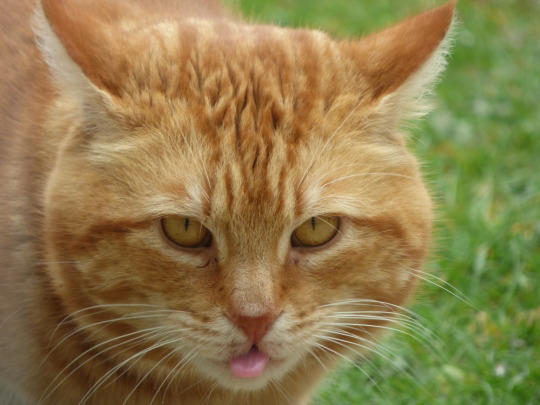
Cat’s tongue
I’ve made myself think now (and so early in the morning) is there a plant called Cat’s Tongue, or am I confusing that with Lamb’s Tongue? Excuse me while I Google and while I’m away, linking back to ‘The Nursery’, this is always useful information...
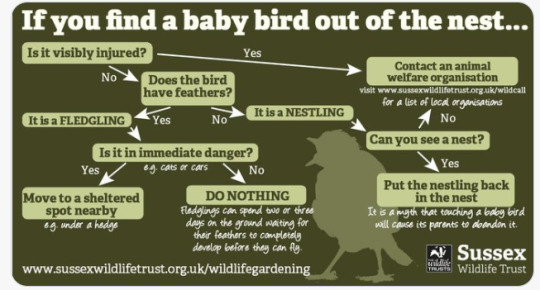
OK, so, Lamb’s Tongue is the plant. Also known as Lamb’s Ear. Cats’ Tongues are of course, a small biscuit. I actually did know that.

I confessed to collecting sheep wool (tenuous segue) and feathers on my walks and I caught House Sparrows shopping from my stock again yesterday.
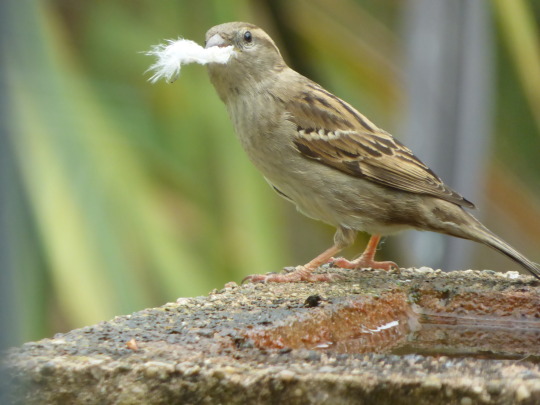
Her and Him

You can link that to the baby bird info too and look, talking of nesting and babies


One of these Robins is still feeding the other and they’re also flying off (to the front I think) with food, so I think they have nestlings and the other pair are bringing their fledglings to the food and bath.

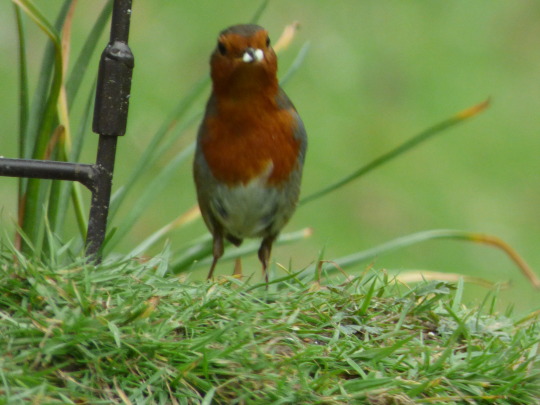

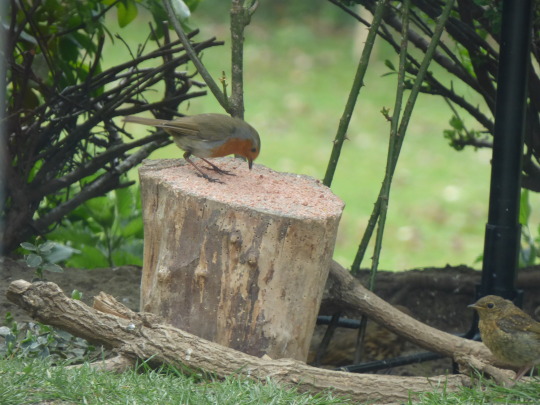
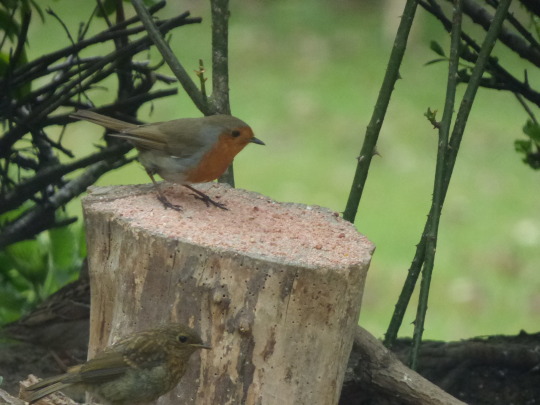
Answers to yesterday’s rainy puzzle can be found
HERE
and I’m going to be posting another really exciting blog over there later too, so keep watching.
1 note
·
View note
Photo
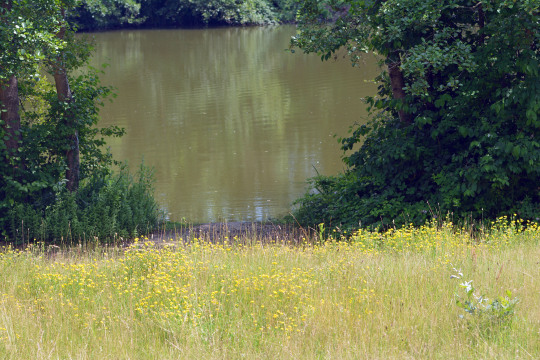


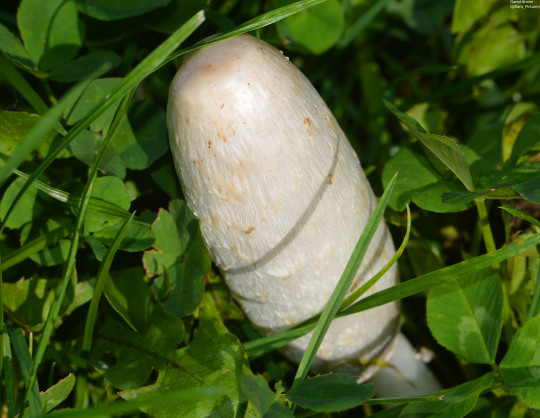
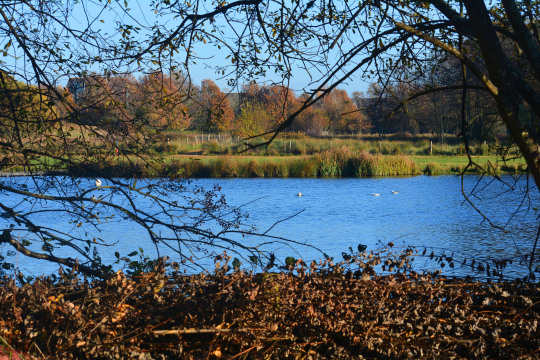
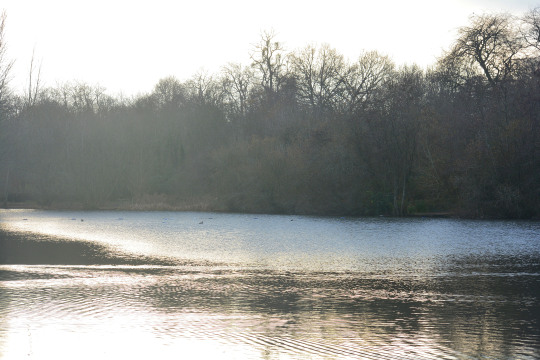
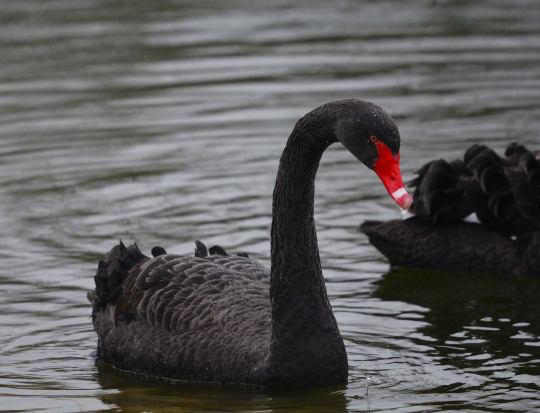

09/02/2022-Wildlife in my working day and a key photo from each month I worked from home full time part 3 of 3
A Song Thrush singing its elegant song, one of my favourite bird songs, as the sun rose at the station this morning was wonderful and uplifting. It was a great day for thrushes generally with Blackbird a star of a monthly thorough e-Bird checklist I am aim to do, at the hotspot for Winchester Cathedral at lunch time. Also here I was astounded to see five dashing Redwings on grass north of the cathedral. An amazing and captivating moment with a bird I’d not seen in Winchester before seeing its distinctive markings of five of these winter migrants felt phenomenal. Of course I was mostly at the cathedral to look for Peregrines as about now in a year is when they make big strides towards the exciting time of nesting. I felt so hopeful making out the piercing eyes of one and fine markings as it sat proud on their north tower nesting site.
Also within the eBird count I saw one Robin, two Blackbirds in total, a pleasing five Jackdaws a key bird seen today, five Feral Pigeons and two Woodpigeons. I saw a few species from the cathedral count at Abbey Gardens where I ate lunch at lunch time too and across the day. Other great wildlife seen today was Magpie, a possible Blue Tit, possible Roe Deers from the train again and Grey Squirrel.
It was a strong day of seeing flowers all day domestic and wild, with stars pre-spring time snowdrops and daffodils adoring the cathedral grounds as well as a stunning periwinkle at Colebrook Street car park a real purple gem a flower I do love. A fantastic wild side of the first day back in the office.
Key pictures whilst working from home in this set:
Lakeside at the height of summer during a Big Butterfly Count something I loved doing whilst working from home in two summers, July 2021
Great Crested Grebe, August 2021
Looking over Kornwestheim lake on a sunny day, September 2021
Shaggy ink cap, October 2021
Looking over beach lake on a sunny day in November 2021
Looking over Concorde lake in December 2021
Black Swan, January 2022
Looking towards the lake from the southern fenced off nature reserve area at Lakeside on Friday to represent February 2022
#butterfly#flower#flowers#birds#birdwatching#august#september#october#november#december#january#february#photography#photos#england#uk#world#nature#earth#lakeside#europe#hampshire#eastleigh#kornwestheim lake#concorde lake#beach lake#day#winchester#lakeside country park#winchester cathedral
5 notes
·
View notes
Text
How to Attract Birds to Your Yard in 9 Steps | Stauffers
Birds are a must for any backyard. They provide natural insect control, beautiful songs, and an educational experience for children and adults alike. Plus, it can be lots of fun to track just how many different types of birds you can welcome to your yard.
You're reading: How to Attract Birds to Your Yard in 9 Steps | Stauffers
Many homeowners have a backyard bird feeder or even a bird bath. But there is so much more you can do to welcome birds and improve your land overall as a wildlife habitat. Interested in learning how to attract birds to your yard? We have the tips you need to create a backyard birding paradise.
Have a specific question about how to attract birds to your yard? Use these links to skip down through the article and find what you need:
Find a Bird-Friendly Corner of Your Yard
Provide a Variety of Feeders
Buy the Right Food
Add a Water Source
Plant a Bird-Friendly Garden
Provide Plenty of Shelter
Offer Opportunities for Nesting
Learn from Your Birds
Make It Official
1. Find a Bird-Friendly Corner of Your Yard
The first step toward attracting birds to your yard is picking a corner of your yard to focus your efforts. You’ll want to place feeders, bird baths, and other offerings where you can enjoy watching from your home. However, you’ll also need to make sure there is sufficient greenery and cover nearby so that birds feel safe enough to explore. Birds can also be territorial, so you’ll want to space out bird food and shelter options to maximize your yard’s bird traffic.
2. Provide A Variety of Feeders
If you’re interested in learning how to attract birds to your yard, you’ll want to start by buying a few different types of feeders. The feeders you’ll need will depend on the types of birds you’d like to attract:
Tube feeders are best for finches, sparrows, and chickadees
Hopper feeders are enjoyed by finches, jays, sparrows, and cardinals
Suet feeders attract woodpeckers, nuthatches, and starlings
Ground feeders are preferred by cardinals, grosbeaks, and blue jays
Nectar feeders are a necessity for hummingbirds and orioles
Different species of birds also prefer different feeding heights, so experiment with hanging your feeders higher or lower as well. While lower feeders may attract squirrels and other animals, there are plenty of squirrel-proof feeders available to keep your feeders safe for the birds.
3. Buy the Right Bird Food
In learning how to attract birds to your yard, you’ll find that each species has food preferences as well. Just as you might prefer sweet foods over salty, different species of birds have different nutritional needs and seek out foods to fill them.
Read more: Snakes
Dark oil sunflower and suet are great basics that will attract a wide variety of birds. There are also plenty of mixes on the market that are designed to attract a number of species. Other types of food to try include thistle, safflower, nuts and peanut butter, and even mealworms. If you’re not sure what food to buy for your particular feeder, someone at your local home and garden center should be able to help.
4. Add a Water Source
Adding a bird bath or water source is the next step in learning how to attract birds to your yard. When water is available, many species of birds will bathe every day to keep their feathers clean and healthy. Offering shallow bird baths (one to three inches deep) or even building a small pond in your yard will help birds stay clean and hydrated.
Birds listen for moving water, so adding a pump or mister that creates fresh, bubbling water will draw even more feathered friends to your yard. If you live in a cold climate, you may also want to invest in a heater or de-icer to keep your bird bath or pond from freezing . Birds bathe year-round, but often struggle to find water sources in the winter, so having fresh water will make your yard a desirable destination.
5. Plant a Bird-Friendly Garden
Planting a garden with bird-friendly plants is one of the most significant changes you can make when learning how to attract birds to your yard. Native flowers, shrubs, and trees are great choices because they will naturally attract birds that live in your area and strengthen your local ecosystem.
Birds are also drawn to bright colors (especially the color of their own species), an attraction that comes from their breeding instincts. Native species are known for their colorful flowers and berries, so they can do double duty when it comes to attracting birds.
Birds like relatively dense shrubs and trees, so consider this when deciding where to plant your new additions. Different species also like different heights and vantage points, so be sure not only to plant eye level shrubs but also low ground cover, small trees (under 15’), and taller trees (over 15’).
The Best Bird-Friendly Plants
Not sure where to get started with your garden? Check out some of our favorite plants that attract birds.
Shrubs
Plant Name Offering Principal Birds Attracted Glossy Abelia (Abelia grandiflora) Nectar Hummingbirds Barberry (Berberis) Fruit, protection, and nectar Songbirds, sparrows Butterfly Bush (Buddleia) Nectar Hummingbirds Burning Bush (Euonymus alatus) Fruit, protection, and nectar Brown thrashers, cardinals, finches Forsythia Nectar Sparrows, robins, cardinals Daylily (Hemerocallis) Nectar Hummingbirds Hibiscus Nectar Hummingbirds Winterberry (Ilex verticillata) Fruit Bluebirds, brown thrushes, cedar waxwings Honeysuckle (Lonicera) Fruit, nectar Catbirds, robins, wood thrushes Firethorn (Pyracantha) Fruit, nectar, protection Mockingbirds, thrashers, cedar waxwings Rose (Rosa) Nectar Catbirds, cardinals, thrashers, sparrows Spirea Nectar Warblers, wood thrushes, robins European Cranberry Bush (Viburnum opulus) Fruit, nectar, protection Bluebirds, robins, wood thrushes Doublefile Viburnum (Viburnum plicatum) Fruit, nectar, protection Cedar waxwings, robins, finches Tea Viburnum (Viburnum setigerum) Fruit, nectar, protection Cedar waxwings, purple finches
Trees
Read more: What is a Solar Garden? | Pivot Energy
Plant Name Offering Principal Birds Attracted Mimosa (Albizia) Nectar Hummingbirds Serviceberry (Amelanchier) Fruit, nectar Blue jays, cardinals, flickers Birch (Betula) Fruit Goldfinches, warblers Dogwood (Cornus) Fruit, nectar Thrashers, finches, robins Apple & Crabapple (Malus) Nectar Bluebirds, flickers, hummingbirds, finches, and more Oak (Quercus) Nectar, protection Robins, nuthatches, thrushes, grosbeaks
Evergreens & Vines
Plant Name Offering Principal Birds Attracted Azalea Nectar, protection Hummingbirds Trumpet Vine (Campsis Nectar Hummingbirds Clematis Nectar Hummingbirds Blue Holly (Ilex) Fruit, nectar, protection Waxwings, flickers, robins Juniper (Juniperus) Fruit, nectar, protection Bluebirds, cardinals, sparrows Honeysuckle (Lonicera) Fruit, nectar, protection Bluebirds, sparrows, goldfinches Spruce (Picea) Fruit, nectar, protection Finches, grosbeaks, grouses, crossbills White Pine (Pinea) Nectar, protection Blue jays, finches, mourning doves Yew (Taxus) Nectar, protection Finches, robins, grosbeaks Hemlock (Tsuga) Fruit, nectar, protection Robins, warblers, chickadees
6. Provide Plenty of Shelter
In addition to creating shelter with greenery, some birds (like bluebirds, sparrows, and chickadees) like the safety, warmth, and shelter of a bird box or bird house. Install your shelter on a post or tree trunk to protect from ground predators.
Make sure the entrance hole is only as large as the intended species. This prevents larger birds like hawks from getting inside and defeating the purpose of the types of bird shelters you’ve added to your yard.
7. Offer Opportunities for Nesting
Once you’ve learned how to attract birds to your yard, you’ll need to find ways to make them stay. One of the best ways to ensure a constant stream of birds all year long is to encourage birds to build nests in your yard.
In addition to creating a welcoming environment full of bird food and shelter options, bird-friendly plants, and reliable water sources, you can provide birds with nesting materials. Simply fill an empty suet cage or old feeder with pieces of small, organic material and hang it for birds to find. Grass clippings, dried weeds and leaves, and even pet hair are all great materials for nest building. And, since they’re all organic material, they’ll decompose naturally and won’t encourage litter in your yard.
8. Learn from Your Birds
If you’re looking to learn how to attract birds to your yard, look to the birds. Every species, every bird, and every environment is different, so keep an eye on your yard’s birds, when they visit, where they spend their time, and which foods they like best. Then you can adjust your setup over time to maximize your yard’s birding potential.
9. Make it Official
Once your yard is teeming with birds, consider certifying your backyard as a Backyard Wildlife Habitat with the National Wildlife Federation. To make it official, you’ll need to follow the Certified Wildlife Habitat requirements:
Three different food sources (from feeders or plants)
One clean water source
Two different shelter sources (including natural and manmade)
Two different nesting places (including natural and manmade)
You’ll also need to employ practices from at least two of three sustainable gardening categories as designated by the NWF. For the full requirements and to get your garden certified, visit the National Wildlife Federation’s website . Be sure to get the entire family involved in the certification process so everyone can learn more about gardening, birding, and sustainability.
Get all the supplies you need to build a backyard birding haven from Stauffers of Kissel Hill . From bird seed to native plants to free advice from our experts, we have it all!
Source: https://livingcorner.com.au
Category: Garden
source https://livingcorner.com.au/how-to-attract-birds-to-your-yard-in-9-steps-stauffers/
0 notes
Text
Helping Wildlife Move Back In
March 15th, 2018|Tags: wildlife|0 Comments
.fusion-fullwidth-1 { padding-left: px !important; padding-right: px !important; }
By Leah Rambadt, American Forests
Interested in helping local wildlife reclaim habitat space? Then create your own wildlife habitat garden!
Wildlife habitat gardens are accessible to wildlife all year round. Here are some considerations and preparations you should go through when planning and maintaining your garden.
A backyard converted into a National Wildlife Federation-certified wildlife habitat garden. Credit: Marie T. Reamer
Consider the Basics
A wildlife garden begins with your plants, since you’re trying to replicate pre-development land conditions. When you plant native plant species wildlife depend on, you create a habitat that starts restoring your local environment.
Location/Space
While this may seem obvious, it’s important to be aware of your location and the amount of space available in your yard. Design your wildlife garden to target specific wildlife based on the space available. For example, if you live in the city, you can target invertebrates, small animals and birds.
Create wildlife corridors by planting in open areas of your lawn. This will encourage invertebrates and other small animals to move around more. Instead of fences, you can also plant hedges as borders to act as corridors and cover for various wildlife. Flowering hedges, which grow berries in the fall and winter, can act as a food source for birds.
Be aware that overcrowding your garden can be just as harmful for wildlife movement as providing minimal plant-life for coverage.
Food
Native plants provide nectar, seeds, nuts, fruits, berries, foliage, pollen and insects for wildlife.
A bee pollinates a hawthorn blossom. Credit: Crataegus Monogyna
When you decide to plant native plants, it may seem harmless to grow plant species not native to your local area. However, doing so can negatively affect the local wildlife. You should only plant local, native species in your garden, since they are the ones local pollinators have evolved to rely on.
To find out the types of plant-life native to your area, search the National Wildlife Federation‘s (NWF) plant-finder database or search the web.
While choosing what to plant, consider the types of wildlife you want to attract, and learn their habits. This will allow you to accurately select the best plants to include in your garden. You should plant a variety of vegetation for all seasons, so wildlife will have food all year round.
Feeders can supplement natural food sources. By regularly providing a diversity of food, your garden can attract a range of birds. Make sure to provide a cover to keep squirrels from raiding the feeders.
Water
Provide a water source. Birds may also use a water source as a birdbath, while various insects may use it for a breeding ground. The container should have sloped sides to allow easy access.
Cover
The trick to providing good cover for wildlife is resisting the urge to completely clean your yard. Some of the “mess” you leave behind makes a good shelter for wildlife.
Soil: Unless you’re planting, don’t dig your garden soil, and lay down compost on top to increase the invertebrate (earthworm and beetle larvae) population. This also provides a foraging site for birds like robins.
Vertical Space: If you have space, you can encourage winged and crawling wildlife into an urban garden on a wall (i.e.: insect hotel, climbing vines).
Insect hotels hanging on walls saves yard space while still providing a habitat. Credit: RBC Blue Water Roof Garden
Garden Glade: Plant woodland flowers in succession under trees to provide shelter for invertebrates and frogs.
Piles: Put logs and piles of sticks under bushes and around garden edges to provide shelter for a variety of animals. Grow ivy or place sods of earth on top for humidity. Compost, trimmings, and decomposing and discarded garden off-cut piles work as well.
Lawn: Keep the center of your lawn short for foragers, and leave the edges long for the invertebrates.
Places for Wildlife to Raise Their Young
Most of the habitats listed above are good locations for wildlife to raise their young. You can also provide birdhouses or nesting boxes for birds. Keep in mind that some species of wildlife need a completely different habitat during their juvenile phase than they do as adults.
An eastern bluebird uses a nest box to shelter its young. Credit: Hazel Erikson/Audubon Photography Awards
Sustainable Practices – How to Manage Your Garden
Native plants should be of genuine native stock, not of continental origin. The wildflowers should also have been cultivated from legally collected seed, not dug up from the wild.
Avoid using peat.
Find alternative forms of compost.
Collect rainwater to refill your water sources.
Recycle: Use reclaimed, old materials when building raised borders and other garden structures.
Avoid using pesticides and use non-toxic, non-chemical alternatives.
break
What You Can Do Now – Spring Preparation
Late fall through early spring is the best time to sow seeds of various native wildflowers that support wildlife, such as birds and bees. Planting these seeds increases local genetic diversity, since most garden centers only sell plants selected and cloned for certain characteristics (e.g., color).
You can get seeds from your backyard, native plant societies, garden clubs, nature centers, and NWF community habitat groups. Plant these seeds outside (times vary by species) to let them germinate.
Good luck with your garden this year!
The post Helping Wildlife Move Back In appeared first on American Forests.
from American Forests http://www.americanforests.org/blog/helping-wildlife-move-back/
0 notes
Text
Tuesday 22nd December 2020
Our Garden Birds. Part 1
♦ bold type indicates an outside link not affiliated to this blog
Before I start today, did anyone manage to see the Great Conjunction last night?
It was thick cloud cover here and the only bright light in the sky was a reflection of the house Landing lights in the bathroom window. I’ll keep looking out and you never know our luck although I have to say considering yesterday was the shortest day, today is putting up some stiff competition and the sky is a sheet of grey.
Back to birds...
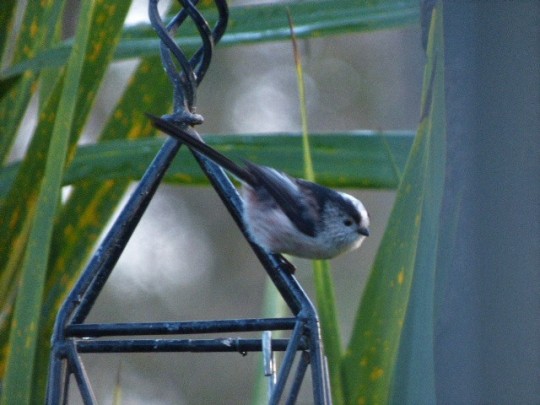
Long Tailed Tit on one of our feeding towers
I’ve been chatting with Ms NW tE and she’s disappointed that her venture into bird feeding hasn’t taken off like she’d hoped and she wanted to have a conversation about that and about why and when do the birds come and go, so I thought that’s what I’d write about today. It’s turning out to be long, so I’ll have to carry over to tomorrow.
Why and How to Feed Garden Birds
First off think about your budget and the amount of time you’re prepared to put into feeding your birds. Second, think about the birds and wildlife you attract into your garden and what their needs are. For example we have a large and active squirrel population and for that reason we tend to avoid feeding peanuts - the cost is just prohibitive, we wouldn’t be able to keep up with them.
We offer hanging feeders with high quality fat balls NB please do not buy the coarse,cheap ones which are less nutritious and avoid the dangerous netting at all costs, Birds can get trapped in the net, it’s a very bad idea.
We have two metal garden obelisk type towers. They’re meant as features or to support climbing plants, but we have nicknamed them Italy and France (the Leaning Tower of Pisa and the Eiffel Tower don’tcha know, No prizes for why they got those names) and we suspend ‘Squirrel Proof’ (excuse me while I convulse with bitter laughter) Fat Ball Cages from each of them.
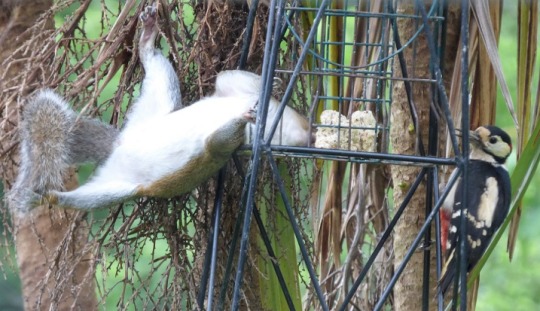
So called Squirrel Proof feeders No offence to designers and manufacturers but this is a battle you will never entirely win.
Squirrels are skilled acrobats and endlessly determined. We’ve used an old football rattle, a saucepan and wooden spoon, a kid’s Super Soaker water gun and any manner of things to frighten them off. They work, sort of, for a while...a short while.
We’ve had squirrels chew through plastic feeders and the ones made of very sturdy wire; learn to open the top lid so we had to secure it with twine and it was a devil then to top up or refill: one little squirrel actually got INSIDE the cage and when all else has defeated them they’ve stolen feeders and taken them away never to be found.
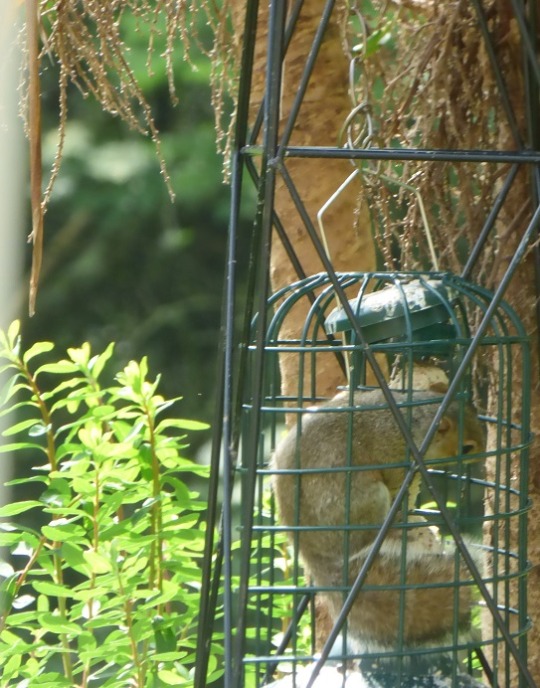
Squirrels really do manage the most outrageous assaults on the food sources
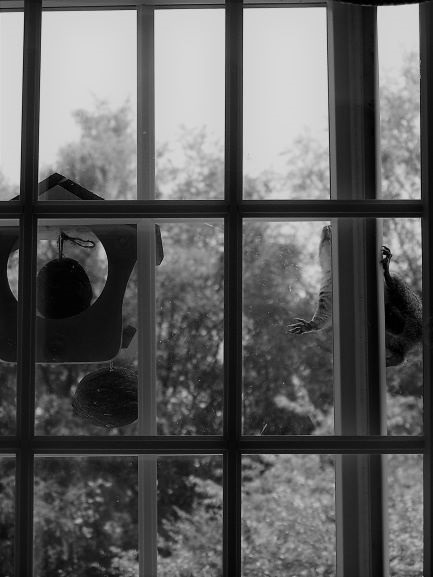
We also offer seed in ground trays of various sizes. The large wooden one has bitten the dust though after being trampled by Deer and the small ones have proven just the right size for tiny twins.

In the end we just accept that they’re hungry and pander to them as much as we look after our birds.

This brings me to another topic, not very savoury, but to be borne in mind - bird food may attract much less desirables. You can’t choose to put out food and always see it taken by what you intend it for and worst case scenario you may find it attracts rodents. Take in food at dusk if you can, sweep up any spilled seed and if you do have an issue then you may have to stop feeding for a time.
Also top priority for bird and garden health is to keep your feeders and the feeding areas clean. Good advice can be found Here and I do recommend to diary note regularly as we all know time runs away with us on the routine tasks.
Where to Place your Feeders
Bear all these points in mind:
Sheltered
The bird table needs to be positioned where there is not too much direct sunlight or in a windy location. Birds will feel safer it is in a sheltered position.
Quiet
If possible locate in a quiet place in your garden, preferably not by a path or any other area with human traffic passing. Remember not to place the bird table too far away from your house then you can still enjoy watching the birds!
One last thing to consider, make sure the bird table is placed away from cat ambush sites including fences which cats can leap from.
Safe Location
The bird table needs to be positioned next to a bush or tree; birds will perch before landing on the bird table to ensure that is it safe for them to land on it.
Raised
A raised bird table is easier to view from your house and safer being away from predators. Most bird tables are complete with a wooden pole but you can hang bird tables from a tree.
Nuthatch particularly like Sunflower seeds and you don’t have to spend a lot of money on suitable containers
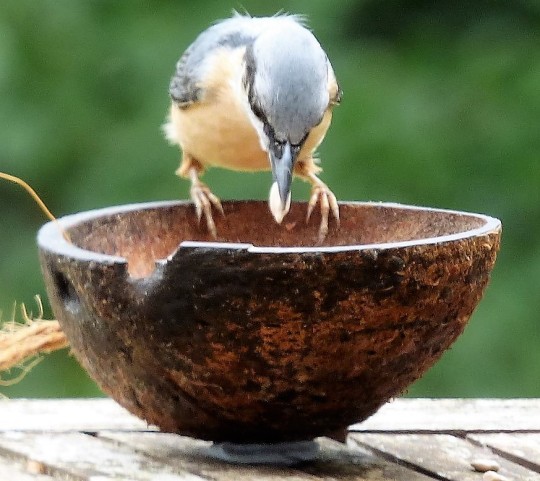
Our feeders are directly in front of the kitchen patio doors so we have great viewing from our seats at the table - this is why so many of my photos are hurriedly snatched shots taken through the glass. We’ve left the dead trunk of the palm as a kind of Totem (our name for it) as the birds do like to fly to the various trunks and perch there or queue before going on to the feeder. The palm also offers some shelter and protection from both the weather conditions and the predatory Sparrow Hawk. We have Bamboo growing in our garden and in the hot weather I’ve been known to cut branches down and use those as a natural parasol too.

A lot of our birds are so used to us now that they don’t mind our presence and are happy to come and feed while we’re around outside. Some, like the Pheasants will more or less come and ask for more supplies, indeed when we had some resident Mallards, they’d peck at the door in the mornings. The Blue Tits will flock around my Crow as he fills up the feeders. We imagine the cry going out ‘The Man’s heeeeeeeere’

Female Common Pheasant above and Male below. The record number we’ve had in the garden at one time was the Season we got up to 22 - cost a fortune in corn

Anything for Me Please?
We’ve also been very lucky that when we had Dennis and now M Flambeau visiting, they are so well fed that they didn’t bother the birds at all. Actually Dennis used to watch the wildlife like he had his own TV channel for viewing pleasure. Here he is with his own personal Christmas tree. The little birds used to come and perch in it while he sat underneath.
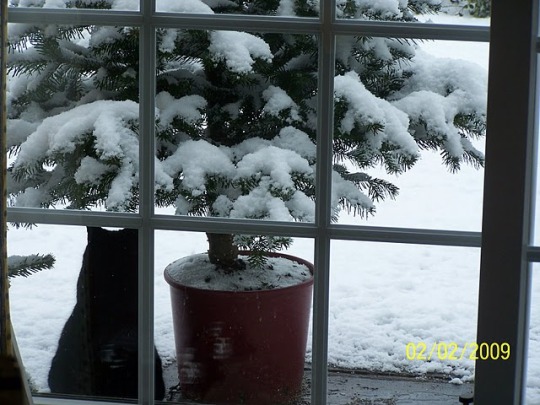
When he first came to live with us he would occasionally give chase to a Butler (Squirrells) or two, but he soon tired of that and saved his energies.
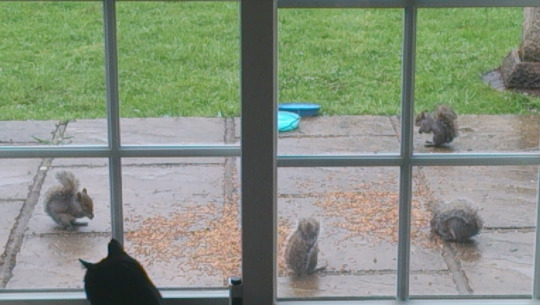
Attracting Birds to your Garden
Just think when the breeding season is highly active, during Springtime, your garden feeders offer a handy and easy source of food for busy parents and their hungry nestlings.

Hungry young Great Tit
In bad weather and harsh winters when natural food is scarce, feeders can be a life saver and please don’t forget to keep fresh water available at all times too.
The important things to remember are good hygiene for your birds’ safety and well being and that if you are going to feed, do it regularly as you don’t want birds wasting their energy seeking out a food source that isn’t available that day.
Much the same as humans have different tastes and diets which are based both on natural preferences and on learned or informed decisions, our animal and bird life is subject to the same. I’ve noticed how some birds learn new tastes and routines to go against type and some stick rigidly to their type. Insect eaters such as Swallows for example haven’t ventured into our feeding areas despite once nesting in our front porch in the Robin box. Robins and the bigger birds like Magpie, Jackdaw and Rooks have found it very tricky to use the hanging feeders, but have persevered and triumphed, adapting their skills and mastering them to reach a food they enjoy. Others will happily scavenge for the bits that fall below.

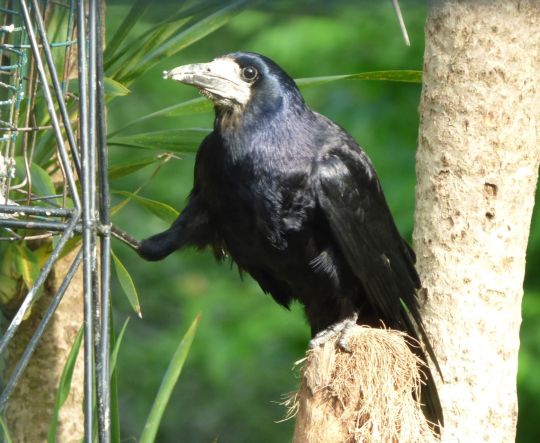
‘Joe’ Rook and his balancing act. Source of the Joe nickname is Here

Starlings taking advantage of the berries on the palm
Top Ten plants birds will appreciate in your garden.
Birds of all sizes can be found sharing and feeding with impeccable manners, while others like Starlings descend like a veritable plague and are noisy and ill tempered with it. It all forms part of the experience of bird watching.
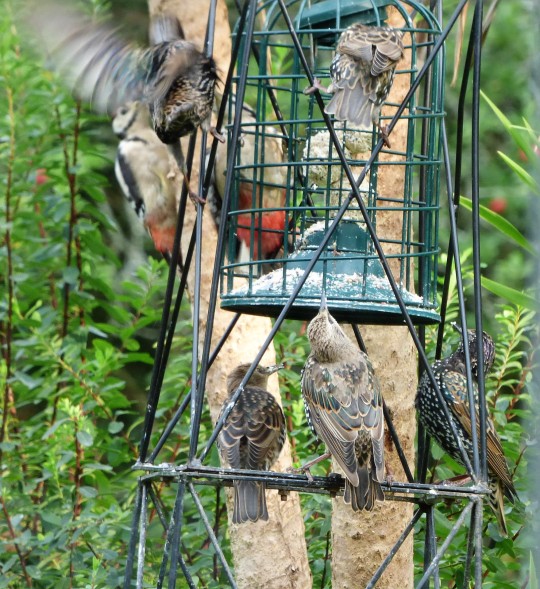
(mostly) Young Starlings and Great Spotted Woodpeckers make short work of three fat balls
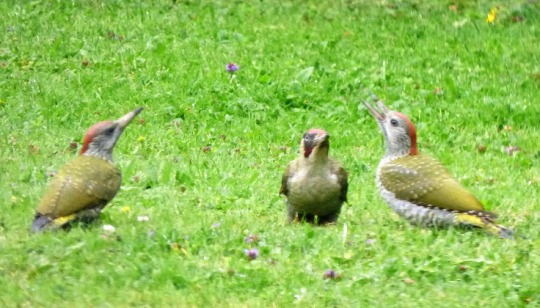
Our gardens are an endless source of food for Green Woodpeckers, who unlike the Great Spotted ones, feed off Ants. We just need thousands more Woodies to keep up the sterling work.
Also insect eaters, Wagtails will come only to drink, although we did have one particularly comical Pied Wagtail who we nicknamed The Inspector because he liked to patrol the ground trays and see off other birds even though he didn’t partake for himself. I believe the expression for that is Dog in the Manger
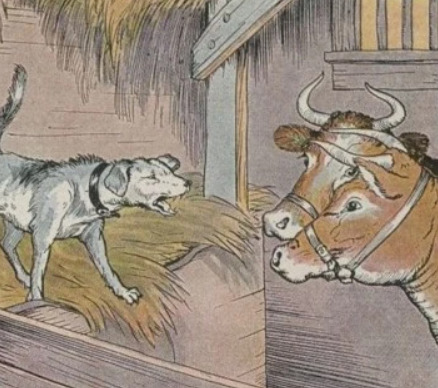
Generic internet illustration
What's the origin of the phrase 'Dog in the manger'?
The infamous 'dog in a manger', who occupied the manger not because he wanted to eat the hay there but to prevent the other animals from doing so, is generally said to have been the invention of the Greek storyteller Aesop (circa 600 BC).
We happily ascribe this expression to Aesop, disregarding the lack of evidence that he even existed.
Many of the fables that have been credited to Aesop do in fact date from well before the 5th century BC and modern scholarship doesn't give much credence to the idea that Aesop's Fables, as we now know them, were written by him at all. Accounts of Aesop's life are vague and date from long after his death and some scholars doubt that there ever was a real Aesop. If he existed at all, it was as an editor of earlier Greek and Sumerian stories rather than as the writer of them.
Nothing written by Aesop now exists in any form. Nevertheless, you can go into any bookshop and buy a copy of 'Aesop's Fables'
I never actually thought of the expression as one of the Fables. The one that always springs to my mind is that of The Tortoise and the Hare, or the Hare and the Tortoise as it appears on the link above.

The carved staircase at Thornton Hall Hotel, Wirral - with scenes from Aesop’s Fables (est c1892) We used to go often for Sunday lunch when the girls were small
Once young broods are successfully raised you might notice feeders fall out of favour for a while. The wild foods like seeds and fruits in hedgerows and spilled grains from the harvest, mean birds can assert their independence and do their natural thing. They tend to return when they need to. Long Tailed Tits are a classic example of this behaviour taking long breaks in the woods and being missed very much by us. It’s great when they return.
Birds often disappear and go ‘into hiding’ after breeding when they moult and need time to recuperate, get their strength back and replace their flight feathers, Poor worn-out things.

Feeding birds can also have a side benefit - since the G S Woodpeckers became so very fond of the fat balls, we’ve noticed attacks on the bird boxes have ceased (fingers crossed) and everyone’s happily well fed.
To be continued.

Male Woodpecker using a crack in the palm to hold steady a piece broken from a fat ball
And do remember, as I said, in both hot weather and cold, please leave fresh, clean water for the birds to drink and to bathe. You don’t need a dedicated bird bath, they’re not fussy and really do appreciate a water source.

Little and Large, or should I say very large and little. Sparrowhawk above on the bird bath and Goldfinch below.

Decorations from the Standen Courtyard Christmas Trees

Two handmade heart decorations today. I thought we could do with seeing something nice and bright and different. These two are particularly beautiful and well crafted.

December 22nd Advent Door. The ever popular Blue Tit
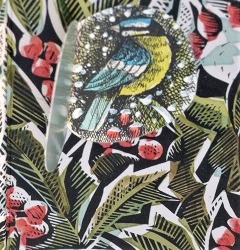
The Nature Watch Nativity

The Shepherds were frightened at the sight of a brilliant light in the sky, but an Angel appeared and told them they should not be afraid as there was wonderful news to share. The lowly Shepherds were the first to be told of the birth of the baby Jesus.

Christmas Hymn of Choice today from King’s College Choir, Cambridge
‘Angels from the Realms of Glory’
youtube
#caring for garden birds feeding birds Advent decorations Christmas#Nativity Goldfinch Sparrowhawk Woodpeckers#Squirrels nature photography
0 notes
Photo
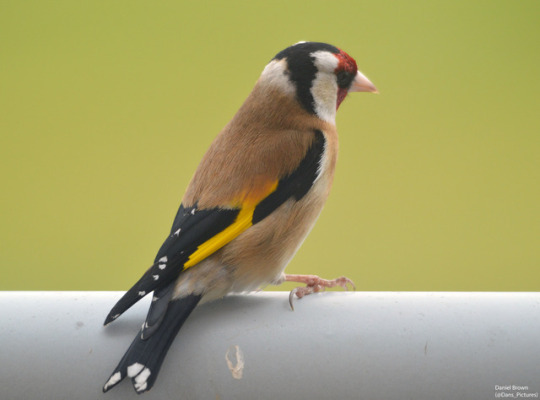

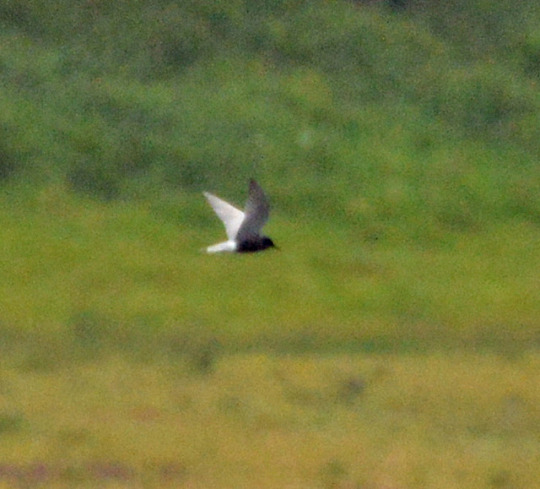
30/4/17-Goldfinches nesting out the front and my first ever Black Terns and more at Blashford Lakes
As I mentioned down the bottom of yesterday’s blog my Mum had informed me we have Goldfinches nesting in the wisteria the climbs up the wall at the front of our house, and whilst watching a football match early this afternoon I saw a couple of birds sitting on the balcony next to the plant as they came and went. One had nesting material in its mouth and the other I took the opportunity to get a close up photo of, the 1st picture in this photoset. This is very exciting times for us as other than maybe Swifts in the roof of my Dad’s house which is my childhood home I’ve never had a bird nest in the garden or anything. On top of that the Goldfinch is probably my favourite garden bird as its so bright and special to see on your patch so to potentially get the chance to follow them create new life is a very exciting prospect.
As the football match ended unsatisfactorily for my side the rain had set in, but I had requested we go to Blashford Lakes this afternoon in the hope of seeing Swifts and Common Terns. Its often the case though that when I don’t get much luck in football or something else in my life on the same day I get lots of wildlife or birding luck and today certainly lived up to that! We arrived at Blashford Lakes and I firstly went into the Tern Hide overlooking Ibsley Water as I always do and within minutes I had got a year tick, the lovely Ringed Plover flying onto the gravel in front of the hide. This is a bird I have a big respect for as specific habitat means its not always that easy to see, and until last year I hadn’t seen one for years when I saw one here also, so to see them in consecutive years is something that makes me feel very lucky. Next I added to my year list again as I saw my first Common Tern of the year, something I’d go onto see a lot of in the trip. Soon after this I took the 2nd picture in this photoset of a Lapwing chick to further embrace spring and the breeding season today which was great.
After this there was much talk in the hide about Black Terns people had seen out on the water, something I had never seen. I scanned at the back getting many more glimpses of Common Terns with the Black Terns on my mind. To my delight I saw one and I instantly knew what it was. This was a bird I’d wanted to see for ages so I had looked it up a lot and I saw straight away just what a distinctive bird it is. I was lucky enough to get long but distant views of this beautiful bird and even to see them alongside Common Terns to see how much darker they really are. I managed the very distant record shot of it in the 3rd picture in this photoset. This was a bird I really was thrilled to see and its made me very happy, its my 246th bird in my life and funnily enough it took my year list to 146. When I saw my first Common Tern of the year moments earlier I was conscious it was my 145th so jokingly thought oh I’m only 100 behind my life list total. So to still be in that position after my next year tick was surreal.
The other talking point from my time in what really was the Tern Hide today was lots of Sand Martins flying everywhere and I got a chance to see some close up. When walking from the Tern Hide to the other side of the reserve I saw 10′s of House Martins circling close above my head up against a grey sky which was atmospheric and nice to see. As I arrived in Ivy North hide seeing one of my favourite birds the Jay close up and hearing it land on the roof was a nice intimate encounter.
I moved onto the Woodland Hide when just at the end of my time there someone came in and informed their group of birders that someone in their group had seen a Garden Warbler. This was a bird I hadn’t seen for six years so I went out to have a look and thanks to someone in the group’s directions which I was very thankful for I just saw this bird flitting between the leaves my 147th bird this year. This felt amazing too as this alongside Black Tern and Little Ringed Plover are without doubt right up there with some of my greatest birds seen in 2017. Like I’ve said a lot 2017 has continued from my record year list 2016 for me for just seeing loads of amazing and rare birds and having a really fast start. 2017 is still my highest year list on this date when looking back and its ahead at this stage some way of my 2016 year list now. So naturally the question is being asked can I beat my record 181 bird species seen in 2016 and for a few weeks I’ve been thinking if I’m going to do that I’ll need some life ticks. Today I got one so its just something like that which gives me a little bit of belief that maybe all this similarity to my treasured 2016 year list will end in the same result.
To close the visit we went back to the Tern Hide where I saw the other of the birds I had come for, the Swift gliding iconicly really far back taking my bird year list to 148. Its always when you see your first Swift that you well and truly know the time of year and I had been anticipating this for a while. I was very glad I chose Blashford Lakes one of my most loved nature reserves which I am having a top year at to come to today because this is one of my best wildlife afternoons ever. Its also part of what has already been another brilliant bank holiday weekend for wildlife and photos for me so soon after the last one. Its unthinkable now that I was actually due to work this Saturday and Sunday but I am so glad we decided to change how our department approaches a busy time of year for us slightly because I got out yesterday and today and just had totally amazing experiences. I’ve felt so relaxed and happy ahead of what will be another long and stressful week at work and it feels so good.
Wildlife Sightings Summary at Blashford Lakes: My first ever Black Terns, my first Little Ringed Plover, Common Tern, Garden Warbler and Swift of the year, three of my favourite birds the Great Crested Grebe, Jay and Great Spotted Woodpecker, Swallow, House Martin, Sand Martin, Robin, Blackbird, Goldfinch, Greenfinch, Chaffinch, Great Tit, Blue Tit, Reed Bunting, Pied Wagtail, Collared Dove, Black-headed Gull, Lapwing, Redshank, Mallard, Mute Swan, Coot, Tufted Duck, Gadwall, Greylag Goose, Egyptian Goose, Cormorant, Grey Squirrel and I heard Mediterranean Gull and another of my favourite birds the Green Woodpecker.
#blashford lakes#goldfinch#black tern#garden warbler#little ringed plover#common tern#swift#great crested grebe#green woodpecker#jay#great spotted woodpecker#grey squirrel#amazing#day#bank holiday weekend#willdife#photography#hampshire#england#uk#earth#nature#wonderful#europe#egyptian goose#best#year list#life list#148#246
0 notes